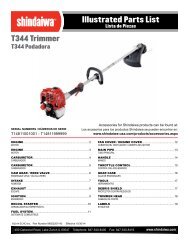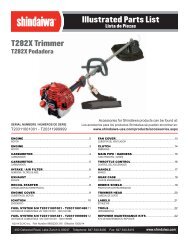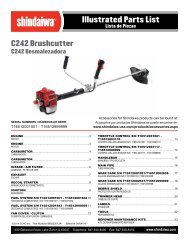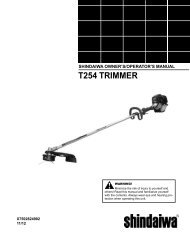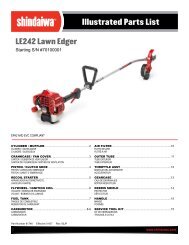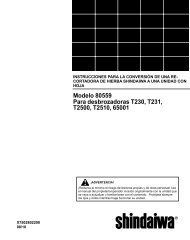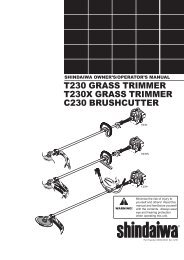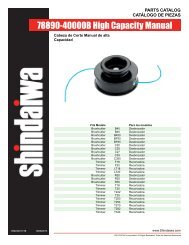T344 TRIMMER - Shindaiwa USA
T344 TRIMMER - Shindaiwa USA
T344 TRIMMER - Shindaiwa USA
Create successful ePaper yourself
Turn your PDF publications into a flip-book with our unique Google optimized e-Paper software.
SpecificationsEngine NameEngine TypeDry Weight (Without guard and strap)Bore x StrokeDisplacementFuel/Oil RatioFuel Tank CapacityCarburetor TypeIgnitionSpark Plug**Spark Plug GapTorqueAir Cleaner TypeStarting MethodStopping MethodTransmission TypeEngine Idle SpeedClutch Engagement SpeedWide Open Throttle Speed (W.O.T.)<strong>T344</strong>4-cycle, single cylinder, air cooled5.9 kg/13.0 lb.38 x 30 mm (1.5 x 1.2 in.)34 cc (2.1 cu. in.)50:1 with *ISO-L-EGD or JASO FD class engine oil700 ml (23.7 oz.)Diaphragm-type carburetorOne-piece electronic, program-controlledNGK CMR5H0.6 mm (0.024 in)16.7 - 18.6 N∙m (148-165 in • lbf)Foam pre-filter; sealed felt main filterRecoilSlide switchAutomatic, centrifugal clutch w/bevel gear2,900 RPM4,500 RPM10,350 RPMSpecifications are subject to change without notice.Emission Control (Exhaust & Evaporative)EPA 2010 and Later and/or C.A.R.B. TIER IIIThe emission control system for the engine is EM (engine modification) and, if the second to last character of the EngineFamily on the Emission Control Information label (sample below) is “C”, “K”, or “T”, the emission control system is EM andTWC (3-way catalyst). The fuel tank/fuel line emission control system is EVAP (evaporative emissions). Evaporative emissionsfor California models are only applicable to fuel tanks.An Emission Control Label is located on the engine. (This is an EXAMPLE ONLY; information on label varies by engineFAMILY).PRODUCT EMISSION DURABILITY (EMISSION COMPLIANCE PERIOD)The 50 or 300 hour emission compliance period is the time span selected by the manufacturer certifying the engineemissions output meets applicable emissions regulations, provided that approved maintenance procedures are followedas listed in the Maintenance Section of this manual.AssemblyPrior to AssemblyIMPORTANT!The terms “left”, “left-hand”, and “LH”; “right”, “right-hand”, and “RH”; “front” and “rear” refer to directions as viewed by theoperator during normal operation.Before assembling, make sure you have all the components required for a complete unit and inspect unit and componentsfor any damage.■■Owner’s/operator’s manual■■Engine and shaft assembly■■Emission Control Warranty Statement■■Cutting attachment shield■■Cutting attachment■■Safety Glasses■■Assembly Tool (s)6



